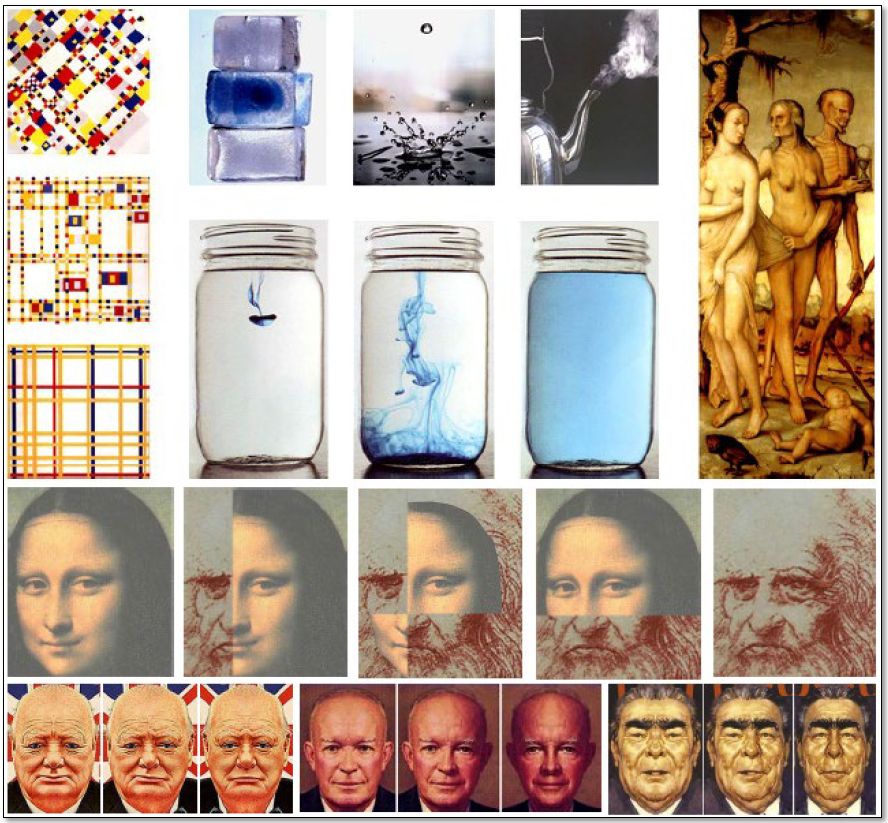552
Views & Citations10
Likes & Shares
From the energy involved in a physical or
chemical process, part of it cannot be utilized as work. Entropy S is the
thermodynamic quantity that is the measure of this energy where the concept of
entropy was first introduced by Rudolf Clausius (1822-1888) in 1865. Entropy is
also a basic and general conception that deals with “order” (low entropy) and
“disorder” (high entropy) of all systems in the universe from human body and up
to the star systems. With the development of science entropy deviates from treatment
of subjects related to heat and work and currently it is used also to analyse
knowledge as well as in economics.
In the following we demonstrate the concept of
entropy by artworks. The paintings of the Dutch artist Piet Mondrian
(1872-1944) on the left column are compositions in three colors: red, yellow
and blue. At the bottom picture parallel lines are described that make an
impression of an ordered system, namely of a relatively low entropy. By going
up the pictures, the parallel lines vanish and a mixture of squares and
rectangles are added that spoil the order. In thermodynamic terms it can be
said that the entropy in the work of art is increasing. The photographs of the
American Walter Wick describe the three states of water. In ice the molecules
are arranged in order and the entropy is low. In the liquid water the
attraction forces between the molecules become weaker and the molecules can
move. In the transition to this state the disorder, namely the entropy,
increases. During boiling the molecules gain free motion, and the disorder
increases and the entropy is higher. The three additional paintings of the
American artist Walter Wick (b.1953) demonstrate a drop of color that is
introduced into water. The molecular diffusion processes disperse the color
molecules in all the volume of the vessel until a uniform dispersion in which
the entropy is the highest.
The work of art “The Three Ages of Man”
(c.1510) on the right-hand-side by the German artist Hans Baldung (c.1480-1545)
demonstrates the concept of entropy also in man’s life. By the passing of time,
demonstrated by the sand clock in the hand of death in a form of a skeleton,
the sleeping baby girl will grow up to a young woman that the end will become
old and die. The low entropy in the baby’s body that her body systems are in
order and normal will increase as she becomes older and will spoil the
interaction between her body organs. When the body will reach maximum entropy
it will stop to perform and the woman will die. Combination of faces demonstrates
the final example of entropy. The first kind is facial combinations of Leonardo
Da Vinci (right image) and his artwork Mona Lisa (left image). The original
faces may be considered of the highest order – minimal entropy - where that at
the center, of the highest disorder, may be considered of maximal entropy. The
other two, of middle order, may be considered of middle entropy. The second
kind is related to face symmetry of Winston Churchill (left image), Dwight
Eisenhower (middle) and Leonid Brezhnev. In each case three images are
presented. In the middle is the original image. On the left are a completely
symmetrical image composed of the right half and its mirror image where on the
right is the left half and its mirror image. As observed, the central image,
namely the original one, is different from the two others indicating a
well-known phenomenon that faces are not symmetrical. Now if we consider the
symmetrical faces as of high order and the original as of low order, then the
symmetrical faces may be looked upon as of low entropy where the original of a
high entropy. In conclusion the authors believe that the presentation of
entropy by different artworks and faces makes this thermodynamic function more
understandable and perceptible.
QUICK LINKS
- SUBMIT MANUSCRIPT
- RECOMMEND THE JOURNAL
-
SUBSCRIBE FOR ALERTS
RELATED JOURNALS
- Advances in Nanomedicine and Nanotechnology Research (ISSN: 2688-5476)
- Journal of Astronomy and Space Research
- Journal of Genetics and Cell Biology (ISSN:2639-3360)
- Journal of Microbiology and Microbial Infections (ISSN: 2689-7660)
- Journal of Genomic Medicine and Pharmacogenomics (ISSN:2474-4670)
- Journal of Agriculture and Forest Meteorology Research (ISSN:2642-0449)
- Journal of Veterinary and Marine Sciences (ISSN: 2689-7830)


